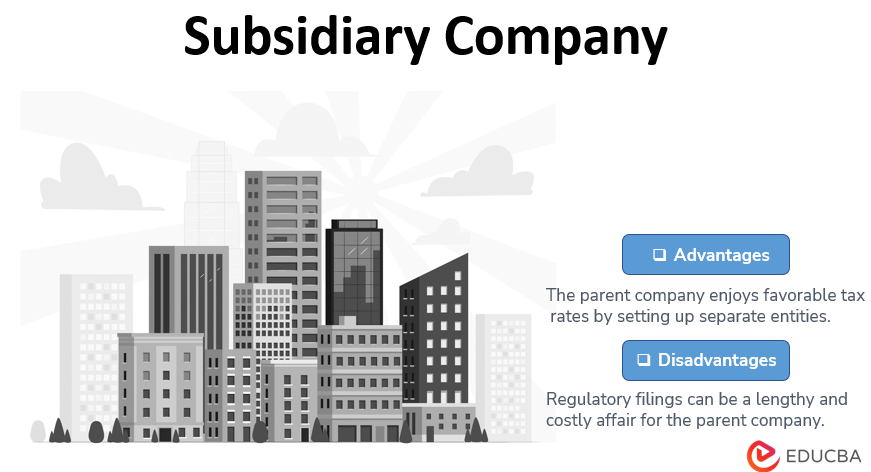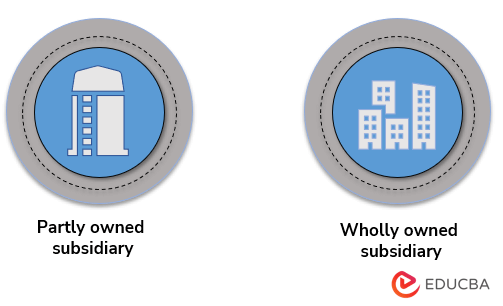Updated July 11, 2023
What is a Subsidiary Company?
The term “subsidiary company” (SC) refers to a company controlled or owned by a parent or holding company. Typically, the parent company has more than a 50% stake in the subsidiary company, which gives the parent entity control of the subsidiary.
In many cases, control is achieved only by being the majority shareholder. If a parent company owns all common stocks of a subsidiary, it is known as a “wholly-owned subsidiary.”
Key Takeaways
Some of the key takeaways of the article are:
- A parent company controls or owns an SC entity.
- A parent company establishes an SC to realize specific synergies, such as enhanced tax benefits, risk diversification, or access to high-earning assets.
- There are two types of subsidiary companies – partly owned and wholly owned.
- A parent-subsidiary framework helps limit the subsidiaries’ liabilities, keeping the parent’s assets safe.
Purpose
National and international organizations create tiers of subsidiaries to consolidate a variety of industries and establish a multinational conglomerate. One of the primary advantages of this structure is that it treats each subsidiary as a distinct legal entity separate from its parent organization. Therefore, the two entities can limit their shared liabilities or obligations, and regulatory or tax purposes consider them separate.
How Does it Work?
A parent company usually establishes an SC to realize specific synergies, such as enhanced tax benefits, risk diversification, or access to high-earning assets. Nevertheless, subsidiaries are legal entities from their holding companies, reflecting the independence of their governance, liabilities, and taxation.
When a parent company owns a subsidiary entity that operates in a foreign land, the subsidiary must follow the law of the land, i.e., the country where it operates. However, by their controlling stake, the parent company can influence the decisions and operations of its subsidiary.
The parent company’s shareholders and the subsidiary can vote to elect the board of directors for the subsidiary. There are instances of overlap of board-member between a subsidiary and its parent company.
Examples
Let us look at some of the most famous conglomerates and their subsidiaries.
Example #1
Berkshire Hathaway Inc. is a US-based multinational company with many subsidiaries, including GEICO, Clayton Homes, Dairy Queen, Business Wire, and Helzberg Diamonds. As of December 31, 2021, Berkshire Hathaway Inc. had 66 subsidiary companies. The parent company follows the simple strategy of purchasing undervalued assets and holding onto them to generate healthy returns. The acquired subsidiaries gain access to broader financial resources while they continue their operations independently.
Example #2
Meta Platforms Inc. is the parent company of the famous technology company Facebook. December 31, 2021, the parent firm had 25 subsidiary companies. Besides being publicly traded on the open market, the parent company has multiple investment portfolios within the social media companies. Some principal subsidiaries include Facebook, WhatsApp Inc., and Instagram LLC.
Types of Subsidiary Company
There are primarily two types of subsidiary companies, which are briefly discussed below.
- Partly owned subsidiary: If the parent company holds more than 50% stake but less than 100% in the subsidiary, it is known as a partly owned subsidiary. In such cases, the parent company doesn’t get complete control over the operations of the SC.
- Wholly-owned subsidiary: If the parent company holds the entire 100% stake in the subsidiary, it is known as a wholly-owned subsidiary. In such cases, the parent company enjoys complete control of the operations of the SC.
Who owns a Subsidiary Company?
A subsidiary company is owned by either a holding corporation or a parent company. While the parent company holds the entire shares in a wholly-owned SC, a parent company has a controlling share in a subsidiary company in the case of a partly owned subsidiary company. In short, the parent company holds more than half of the common stock in a subsidiary company. As the majority shareholder, the parent company elects the board of directors.
How to set up a Subsidiary Company?
To set up an SC, a parent company can create a new entity or purchase the majority stake in an existing company. In the case of a new subsidiary, the parent company must complete the incorporation process similar to any new company. The parent company must register the subsidiary in the state or country where it operates and document itself as the subsidiary owner.
Being the majority owner, the parent company has the right to elect the board of directors for the subsidiary. In many cases, some members elect to sit on the board for both the parent and subsidiary. These members help represent the broader group’s interests while making strategic decisions.
Advantages
Some of the significant advantages are as follows:
- The parent company enjoys favorable tax rates by setting up separate entities.
- It results in limited financial liability for the parent company in the case of losses in the subsidiary companies.
- Subsidiary companies focus on a specific product or technology that strengthens the corporation.
- It helps maintain operational independence in the subsidiary while continuing managerial control.
Disadvantages
Some of the major disadvantages are as follows:
- In the case of a partly-owned subsidiary, decision-making may become somewhat tedious since things have to go through the chain of command within the parent bureaucracy.
- Regulatory filings can be a lengthy and costly affair for the parent company.
Conclusion
Businesses intend to establish subsidiaries to expand their business at minimal risk. Further, it also helps them limit the liabilities and claims of the subsidiary companies, keeping the parent company’s assets safe while resulting in many synergic benefits for the parents.
Recommended Articles
This is a guide to Subsidiary Companies. We also discuss the definition, purpose, working, example, types, setup, and advantages and disadvantages. You may also have a look at the following articles to learn more –





